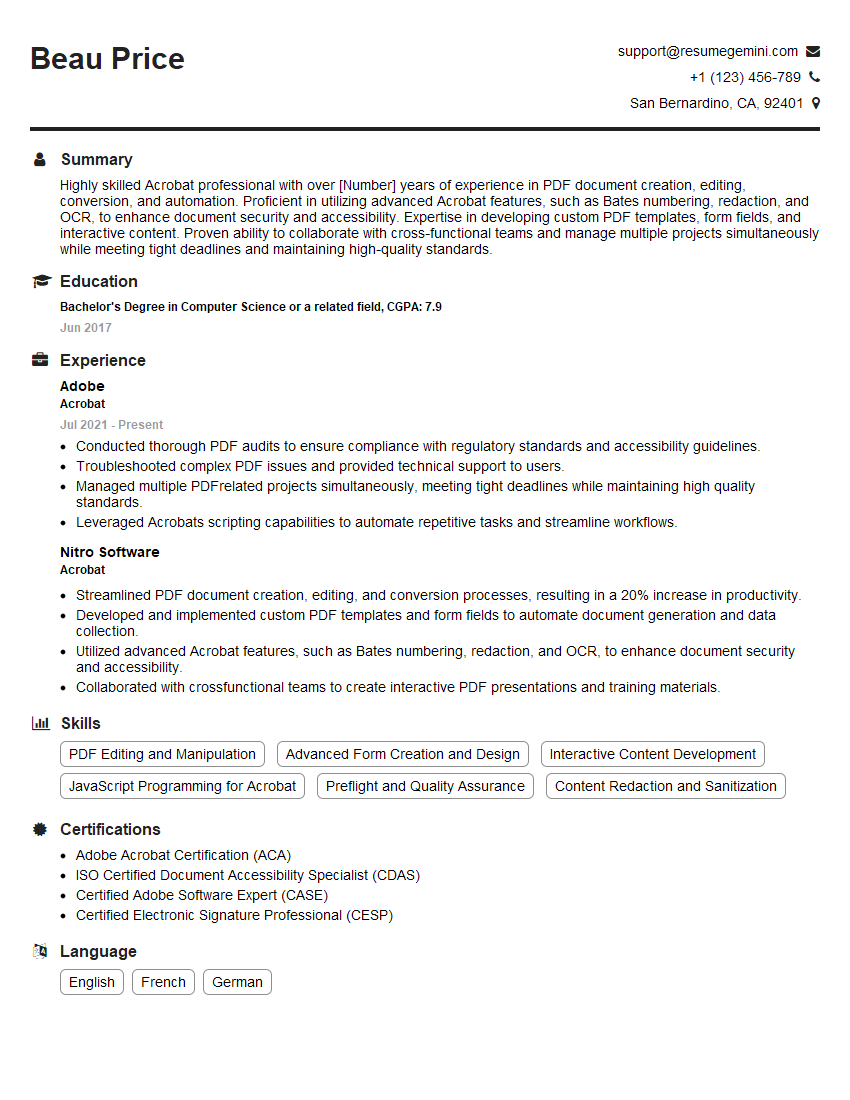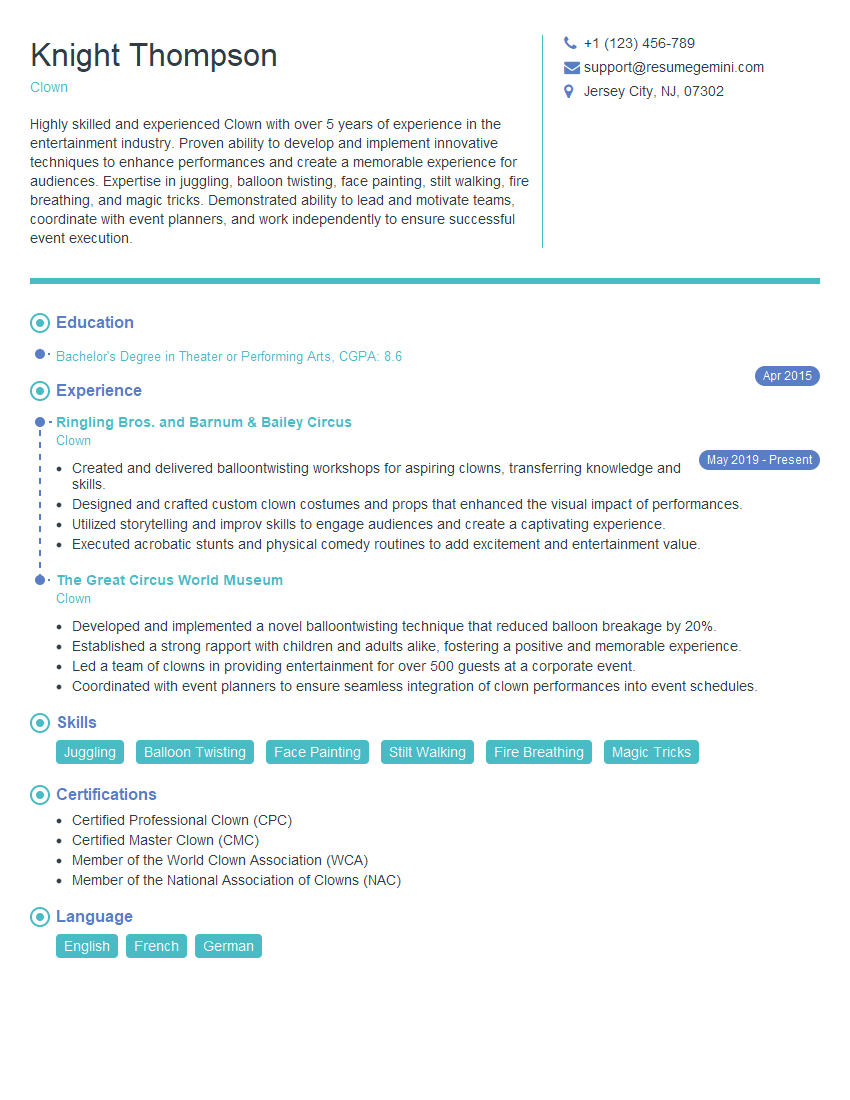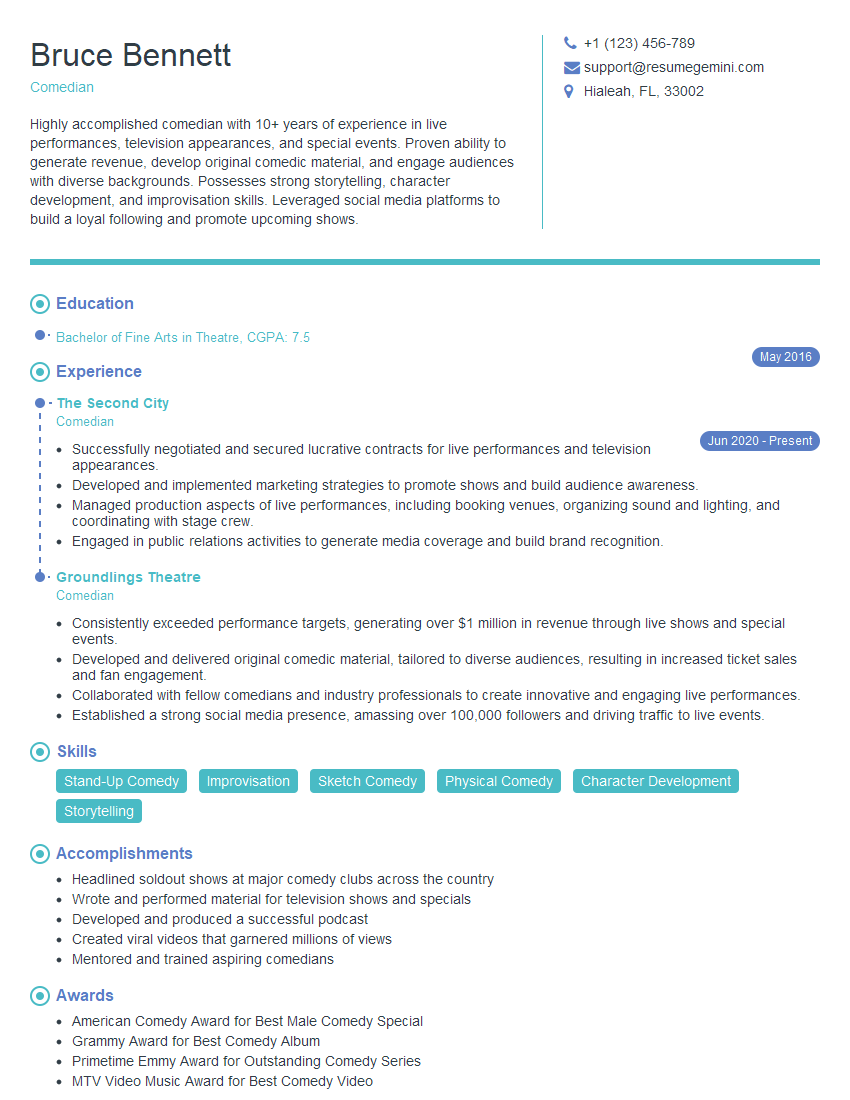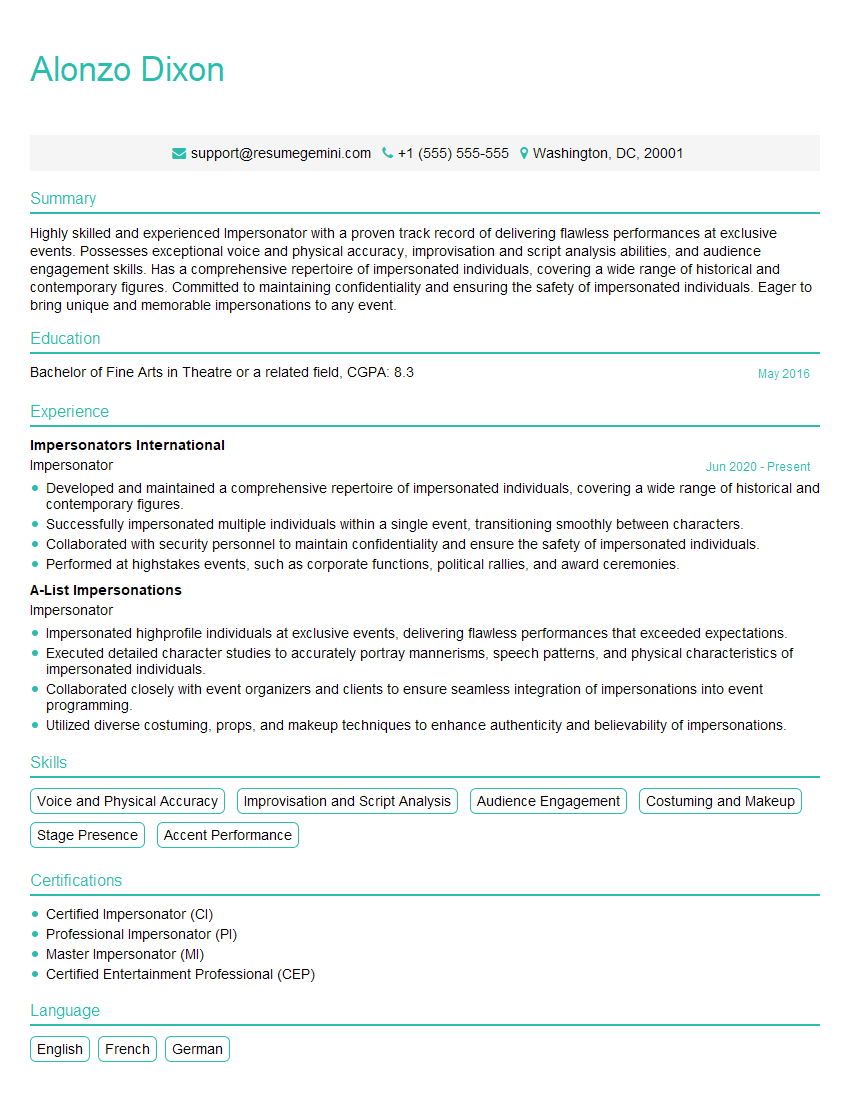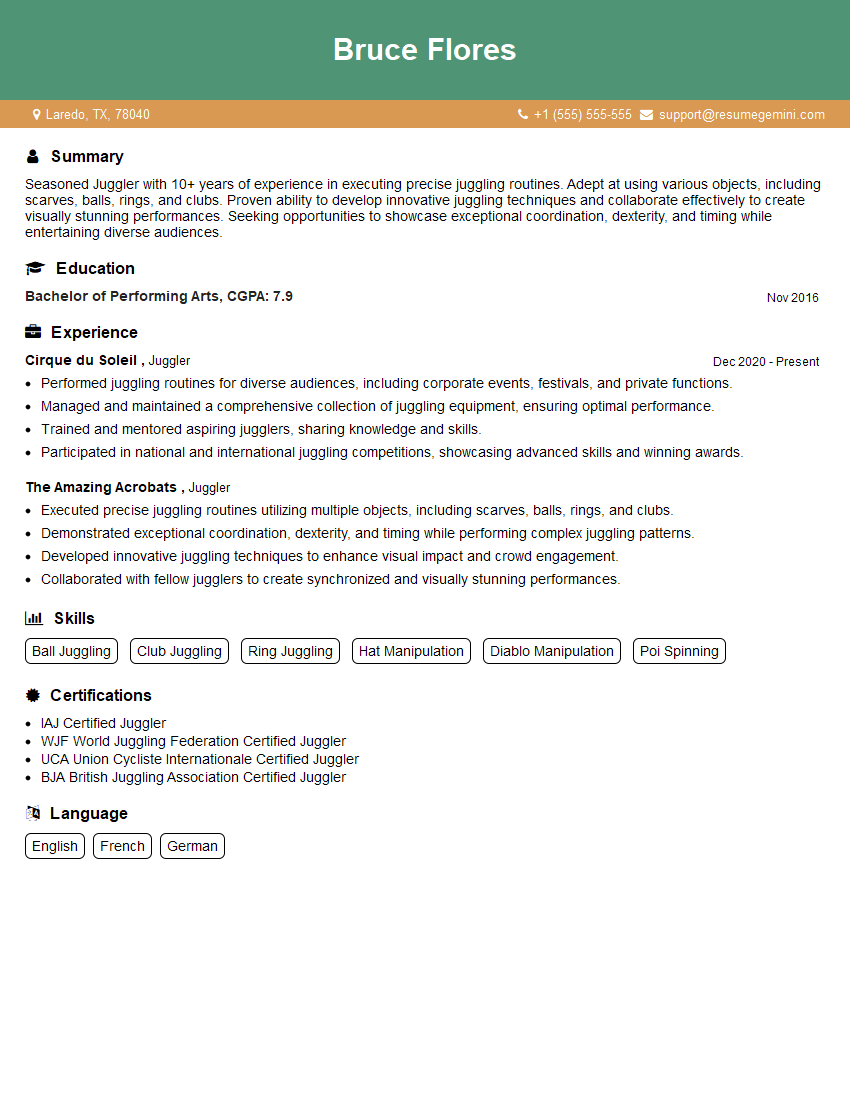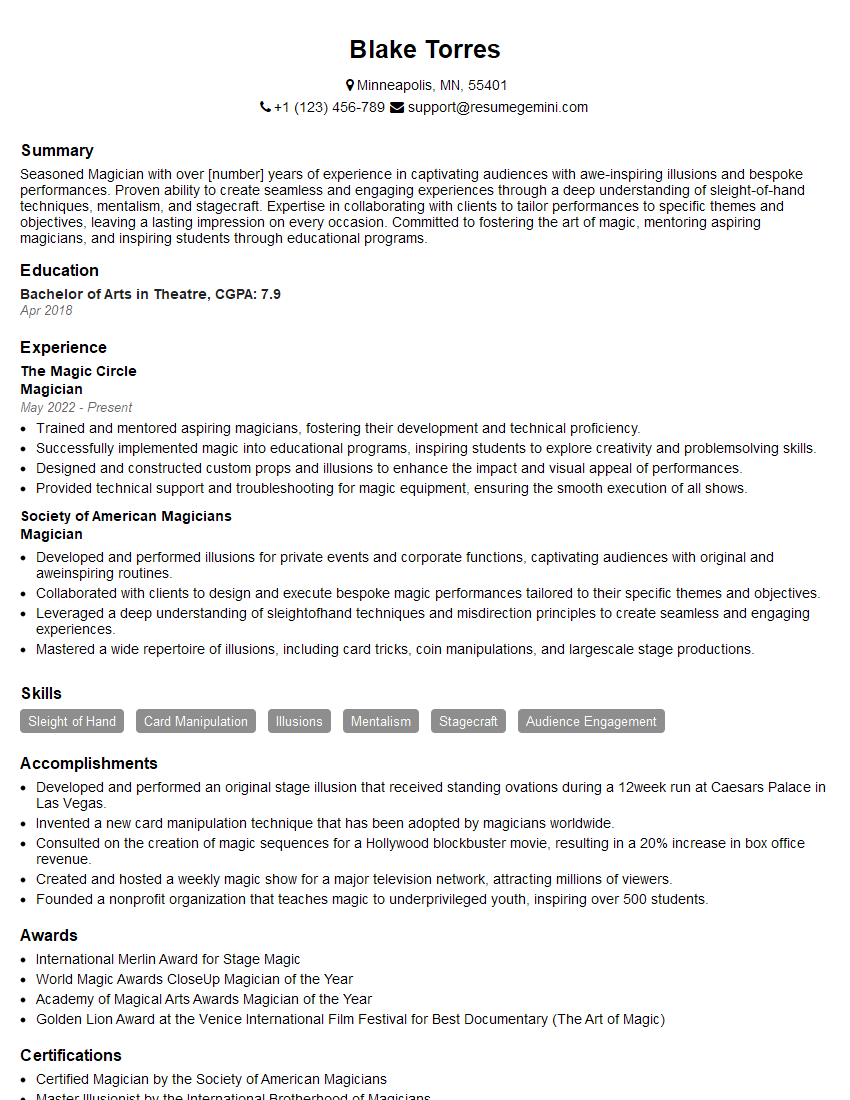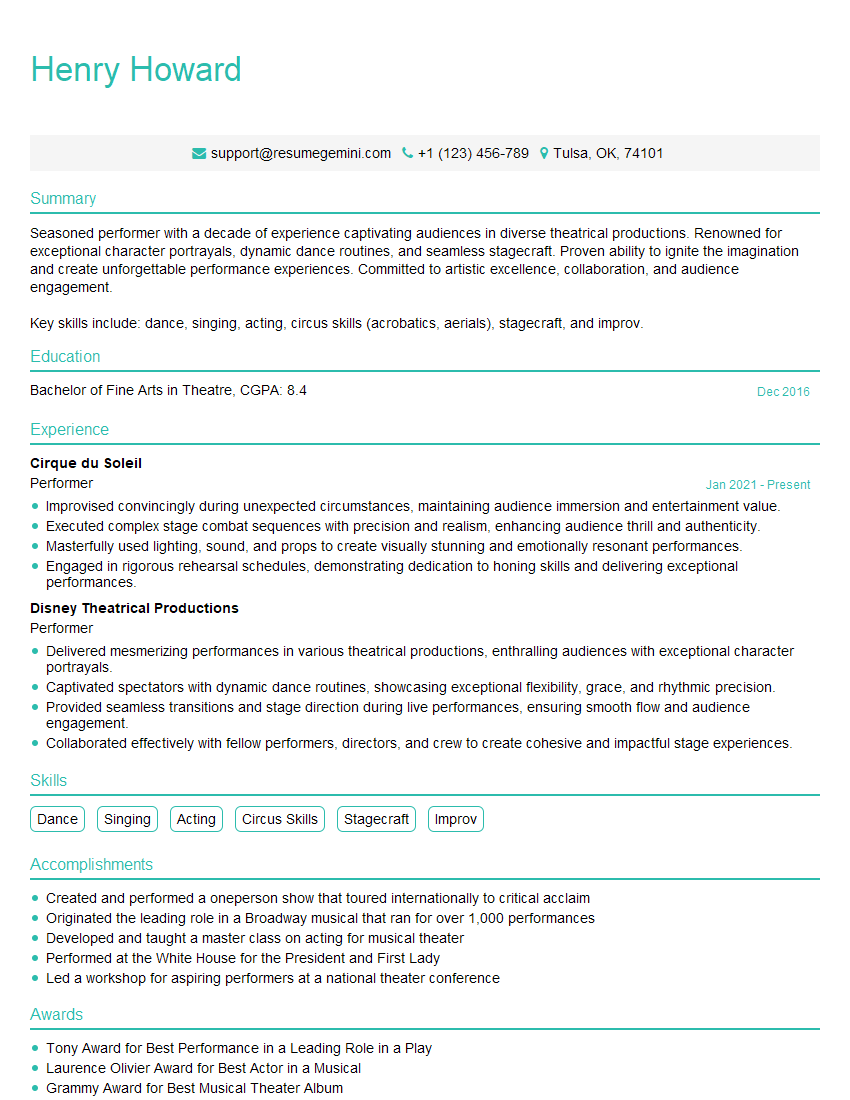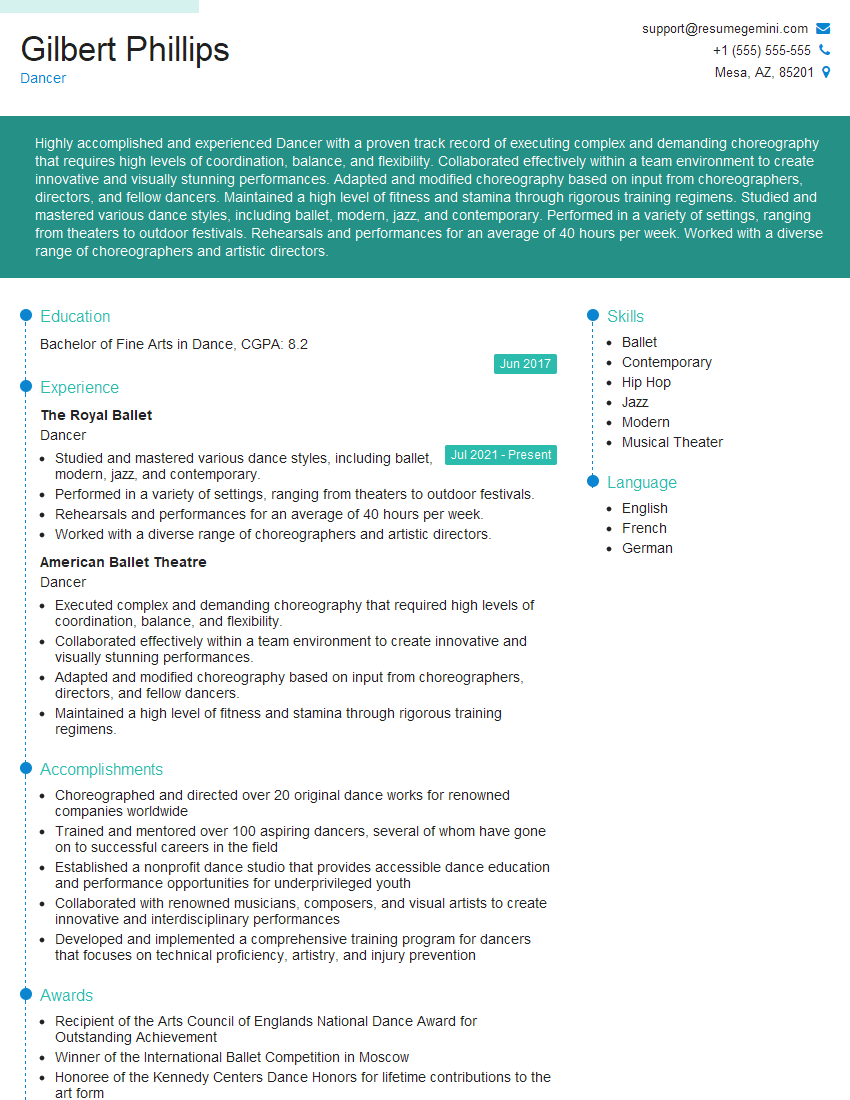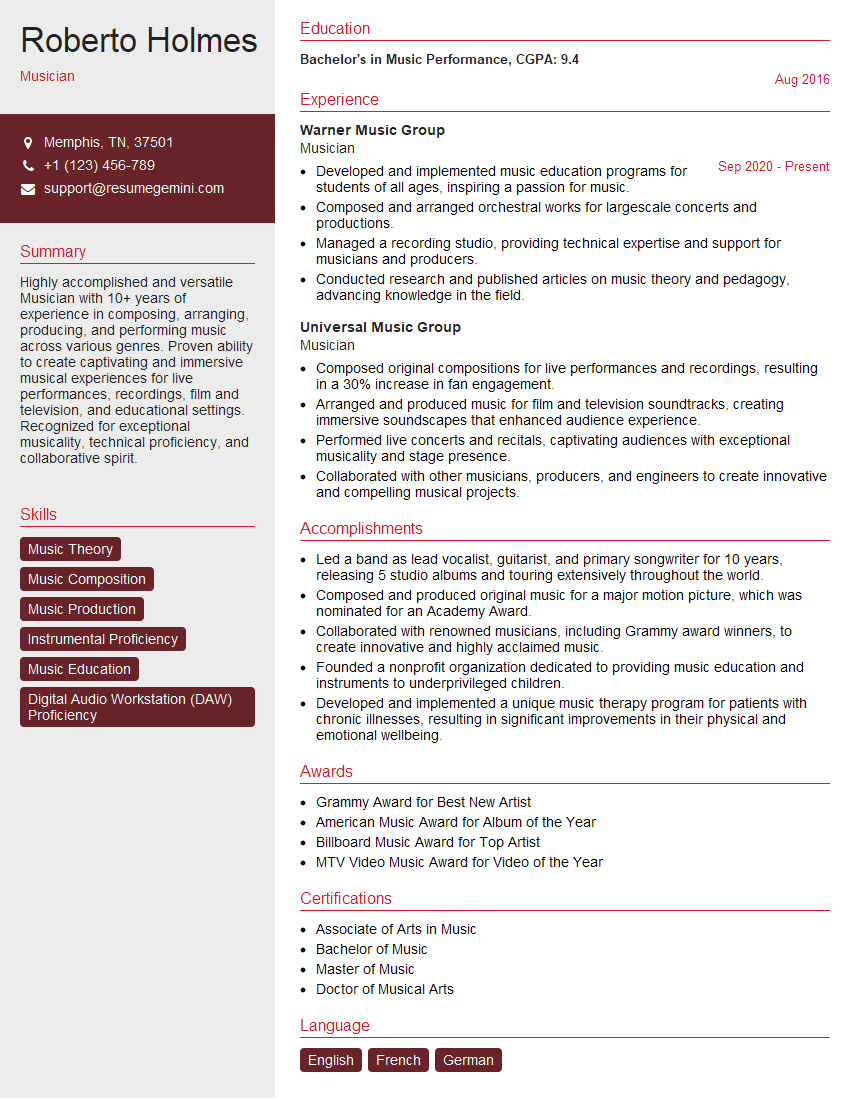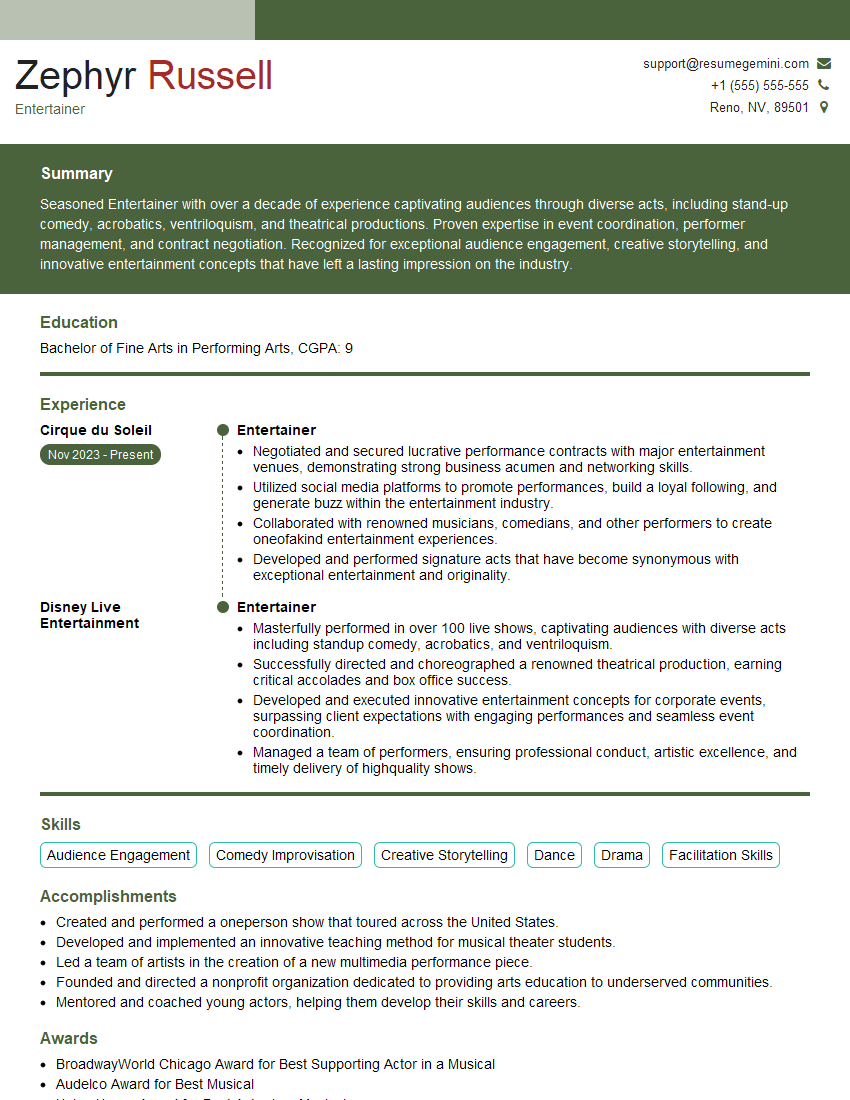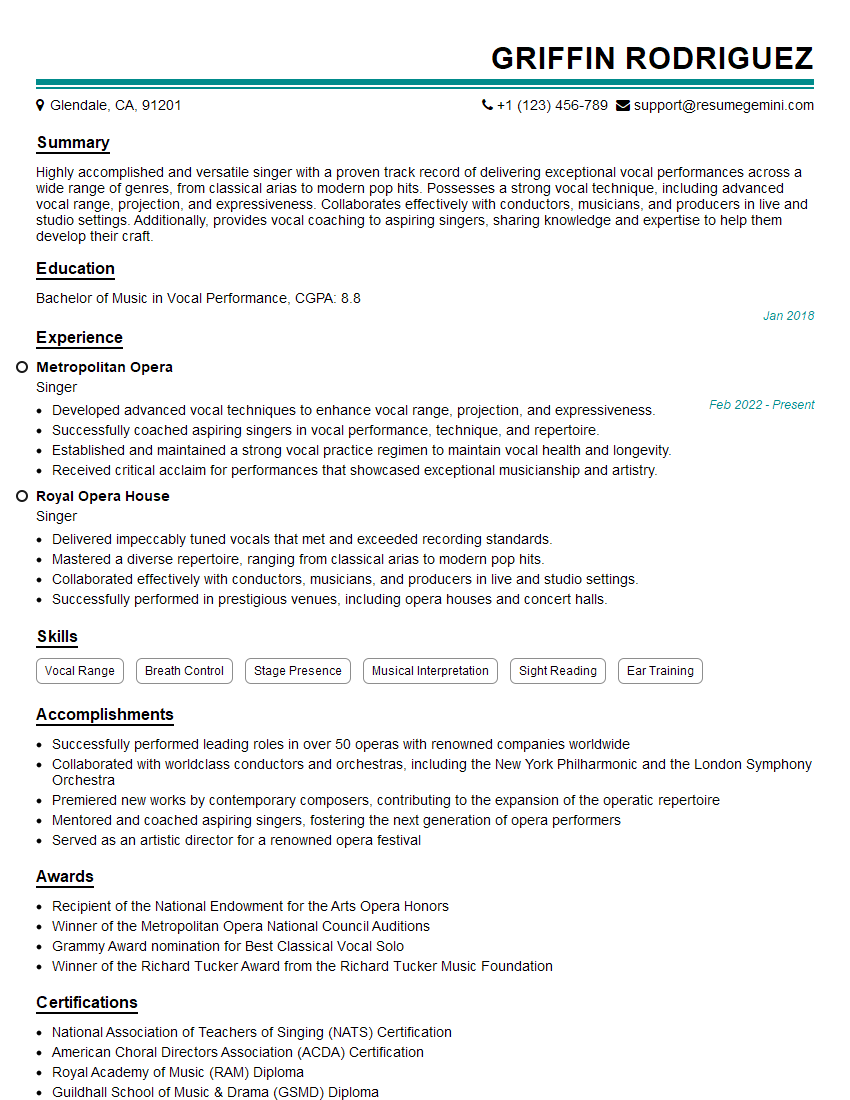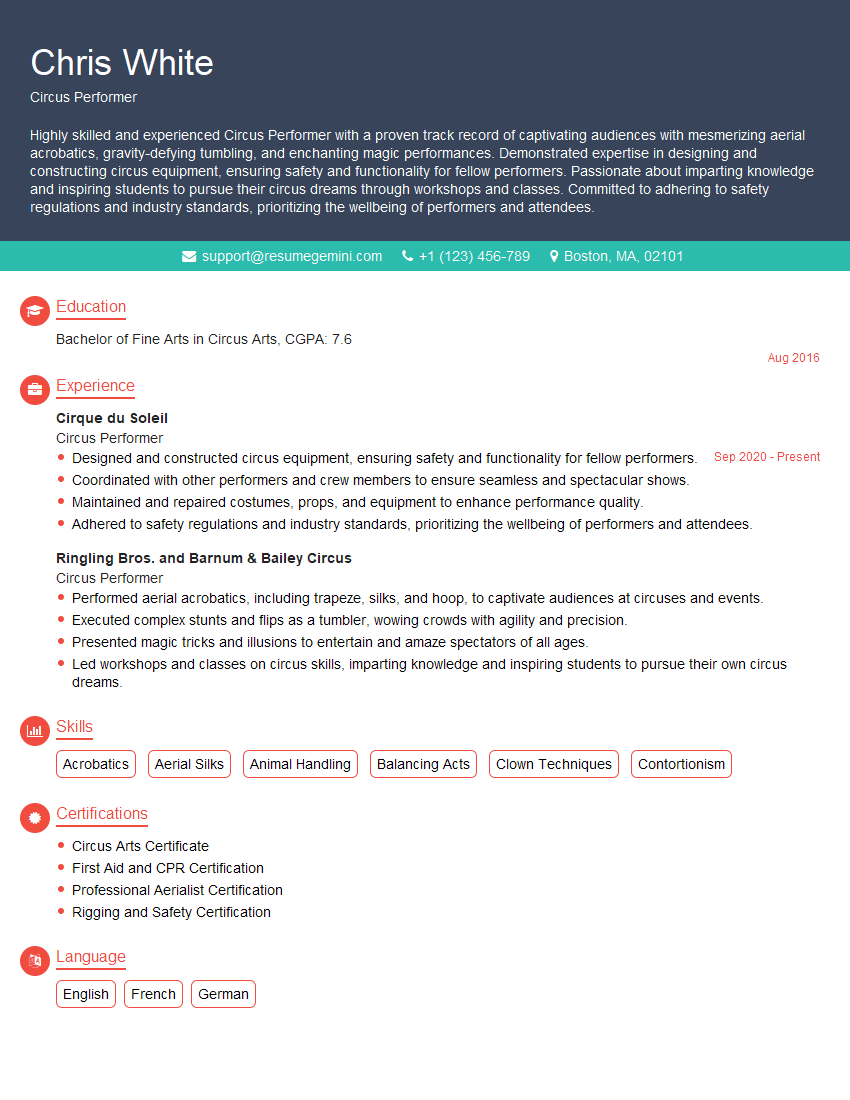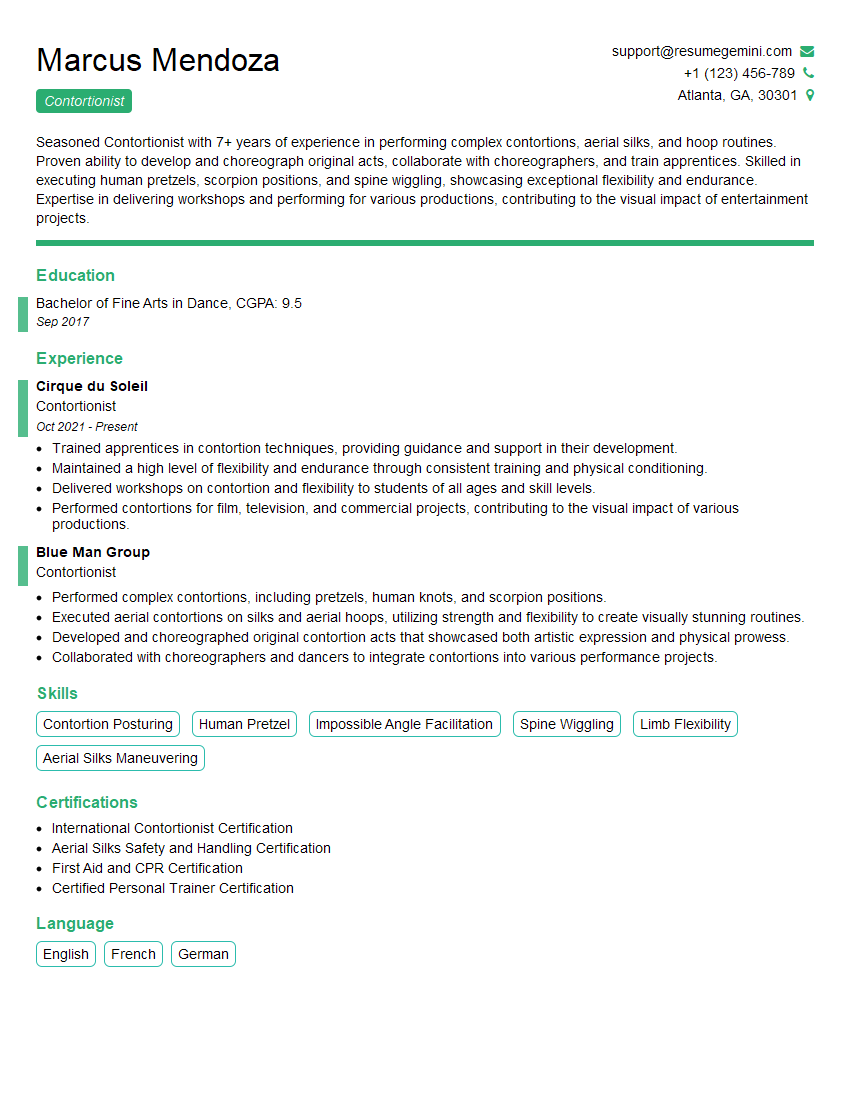Every successful interview starts with knowing what to expect. In this blog, we’ll take you through the top Variety Artist interview questions, breaking them down with expert tips to help you deliver impactful answers. Step into your next interview fully prepared and ready to succeed.
Questions Asked in Variety Artist Interview
Q 1. Describe your experience in various performance styles.
My performance experience spans a wide range of styles, encompassing musical theater, stand-up comedy, magic, and even some acrobatics. In musical theater, I’ve played leading and supporting roles, mastering various vocal techniques and stage presence. My stand-up comedy involves observational humor and audience interaction, requiring quick wit and improvisation. Magic allows me to blend illusion and storytelling, demanding precise movements and audience psychology. Finally, the acrobatics element adds a visual flair and requires dedicated physical training and coordination. Each style demands a distinct skill set, yet they complement each other, allowing for a versatile performance repertoire.
- Musical Theater: Performed in several productions, ranging from classic musicals like Oklahoma! to contemporary works.
- Stand-up Comedy: Regularly perform at open mics and clubs, honing my observational humor and comedic timing.
- Magic: My magic act incorporates sleight of hand, misdirection, and storytelling to create memorable illusions.
- Acrobatics: I’ve incorporated basic acrobatic elements into my performances, enhancing the visual impact and showcasing physical dexterity.
Q 2. What are your primary performance strengths?
My primary strengths lie in audience engagement and adaptability. I excel at creating a rapport with the audience, making them feel involved and entertained. My comedic timing allows me to deliver jokes effectively and improvise when needed. I’m also adept at reading the room, sensing the energy and adjusting my performance to suit the mood. My versatility across various performance styles gives me a significant edge. I can seamlessly transition between different acts, keeping the audience captivated. Finally, my strong stage presence commands attention and creates an unforgettable experience.
- Audience Engagement: I thrive on interaction and tailoring my act to the specific audience.
- Adaptability: I’m skilled at changing my performance based on audience reactions and energy.
- Versatility: My broad range of performance styles allows me to create dynamic and diverse shows.
- Stage Presence: I have a natural charisma and confidence that captures the audience’s attention.
Q 3. How do you adapt your act to different audiences?
Adapting to different audiences is crucial. I gauge the age range, the overall mood, and the setting before I begin. For example, a corporate event will require different material than a children’s party. I analyze their reactions and adjust the pacing and content accordingly. If an audience is responding well to a particular segment, I may extend it, whereas if a joke falls flat, I might move on quickly. This involves actively listening to the audience, reading their body language, and responding in real-time. My versatility in performance styles also helps; I can swap between musical numbers, comedy, and magic depending on the audience’s engagement. For instance, at a children’s show, I’d focus more on interactive games and lighthearted magic, while at a corporate event, the focus would be on clever observational humor and perhaps more sophisticated illusions.
Q 4. Explain your approach to audience engagement.
Audience engagement is the cornerstone of my performances. I use a blend of techniques: direct interaction (asking questions, involving volunteers), incorporating audience participation into my acts (e.g., having someone help with a magic trick), storytelling that resonates with their experiences, and maintaining strong eye contact. I try to make it a two-way conversation rather than a one-way performance. For example, I might start a stand-up routine by asking the audience about their day, creating a sense of shared experience. Or, during a magic show, I might invite someone from the audience onto the stage, making them a part of the illusion. This level of interaction helps break down the barrier between performer and audience, creating a more memorable and engaging experience for everyone.
Q 5. How do you handle technical difficulties during a performance?
Handling technical difficulties requires quick thinking and improvisation. My approach is to stay calm and assess the situation. If the microphone fails, I might use my voice projection techniques. If a prop malfunctions, I’ll improvise a replacement or seamlessly transition to a different segment. I’ve developed backup plans for common issues – extra batteries, alternative props, and even pre-planned jokes that don’t rely on technology. The key is to acknowledge the issue to the audience (with humor if possible) and continue with the performance. Transparency and a positive attitude can turn a potentially disastrous situation into a memorable moment. For instance, if a light goes out, I might jokingly say, “Well, that adds to the mystique!” and continue with a more intimate segment. The most important thing is to maintain the flow and energy of the performance.
Q 6. Describe your process for creating and developing a new act.
Creating a new act involves a multi-stage process. It starts with brainstorming ideas, drawing inspiration from personal experiences, current events, or other artists’ work. Then, I develop a theme or central concept and outline the structure of the act. This includes choosing the appropriate mix of performance styles (comedy, music, magic, etc.). Next, I begin refining the material, writing jokes, practicing routines, rehearsing transitions, and adding visual elements. I often test new material at open mics or smaller gigs to get audience feedback. Finally, I fine-tune the act based on audience reactions, adjusting timing, adding new elements, and removing those that don’t land well. It’s an iterative process involving constant refinement until the act achieves its full potential and is ready for a larger stage.
Q 7. How do you maintain your physical and mental well-being while performing?
Maintaining physical and mental well-being is paramount in this demanding field. I prioritize regular exercise, a balanced diet, and sufficient sleep to maintain my physical stamina. Vocal exercises and physical stretches are integrated into my daily routine to prevent injuries and maintain vocal health. Mentally, I practice mindfulness and stress management techniques like meditation or deep breathing. Connecting with other performers and having a strong support system helps avoid burnout. Taking time for relaxation and pursuing hobbies outside of performing are crucial for overall balance and preventing mental fatigue. Essentially, it’s about creating a holistic approach to well-being, ensuring I’m both physically and mentally prepared for every performance.
Q 8. What are your methods for practicing and rehearsing?
My rehearsal process is multifaceted and depends heavily on the specific act. For musical numbers, it begins with rigorous vocal and instrumental practice, often hours a day, focusing on perfecting technique and emotional delivery. This includes scales, runs, breath control exercises, and meticulous work on phrasing and dynamics. For comedic routines, I spend time refining the jokes, timing, and physical comedy, often recording myself to identify areas for improvement. Rehearsals usually involve run-throughs of the entire act, incorporating costume changes and prop handling, to ensure a seamless performance. I also incorporate feedback sessions with trusted colleagues or mentors to get fresh perspectives.
For example, when preparing a new juggling act incorporating fire, I spent weeks perfecting the individual juggling patterns before integrating the fire poi, paying close attention to safety and practicing in a controlled environment. This involved gradually increasing the difficulty of the patterns and the duration of the fire work.
Q 9. How do you handle stage fright or performance anxiety?
Stage fright is a common experience for performers. My approach involves a combination of techniques. Firstly, thorough preparation is crucial. Knowing my material inside and out drastically reduces anxiety. Secondly, I employ relaxation techniques such as deep breathing and meditation before going on stage. Visualizing a successful performance is also helpful in building confidence. Thirdly, I focus on connecting with the audience; their presence becomes a source of energy rather than a threat. Finally, understanding that it’s okay to feel nervous helps me to manage the experience; nervousness is often mistaken for excitement.
One time, I was performing a tightrope walk with a live band, and my anxiety was palpable. But remembering my breathing exercises and focusing on the music helped me channel that nervousness into focused energy, resulting in a memorable performance.
Q 10. Describe your experience with improvisation.
Improvisation is a vital skill for any variety artist. It allows for spontaneity, adaptability, and a deeper connection with the audience. I’ve honed my improvisational skills through regular practice with improv games and exercises, focusing on active listening, quick thinking, and accepting the unexpected. My experience ranges from quick witty remarks during comedic routines to adjusting musical arrangements based on audience reactions. This requires building a strong foundation in your chosen discipline, so that your improvisation feels natural and integrated into the broader performance rather than a distraction.
For example, during a recent stand-up routine, a heckler shouted a completely unrelated comment. Instead of getting flustered, I smoothly incorporated the heckler’s comment into my next joke, turning a potential disruption into a memorable moment of audience interaction.
Q 11. How do you incorporate audience participation into your act?
Audience participation is a great way to build energy and connection. I incorporate it into my act in various ways, depending on the type of performance. In comedic shows, I might ask for volunteers to participate in simple skits or use audience suggestions to tailor the jokes. During musical performances, I might ask for audience sing-alongs or invite them to participate in simple call-and-response sections. It’s crucial to gauge the audience’s willingness and comfort level; participation should always be voluntary and fun.
For instance, in a magic show, I’d involve the audience in choosing cards or assisting with simple tricks, creating a collaborative feel and making the performance more engaging.
Q 12. What is your experience with costume design and creation?
Costume design and creation is a significant aspect of my work. I collaborate closely with designers, or sometimes design and create my own costumes, ensuring they complement my act, enhance my character, and facilitate movement. This process involves sketching designs, sourcing fabrics, selecting embellishments, and working with seamstresses or tailors. The costumes must be durable, comfortable, and visually appealing, reflecting the style and theme of the performance. The process also requires considering factors such as lighting, stage design, and audience visibility.
For instance, for a steampunk-themed magic act, I designed a costume with intricate gears, brass accents, and Victorian-era tailoring, carefully considering how the costume would work under stage lights and facilitate my movements.
Q 13. How do you handle criticism or negative feedback?
Handling criticism is a crucial part of professional development. I approach negative feedback constructively, viewing it as an opportunity for growth. I analyze the criticism objectively, separating personal opinions from valid points. Constructive criticism helps me identify areas needing improvement, allowing me to refine my act. It is important to consider the source of the criticism, understanding their perspective and intention. Not all feedback is valuable, so I focus on discerning constructive criticism from personal biases.
For example, if a reviewer criticizes a specific joke as being unclear, I’ll rework that joke to improve its clarity, paying attention to its delivery and pacing. Conversely, if a reviewer simply dislikes my style, I’ll acknowledge their preference but likely won’t change my style to match.
Q 14. What is your understanding of stage safety and risk management?
Stage safety and risk management are paramount. I prioritize safety in every aspect of my act, from rehearsals to performances. This includes regular equipment checks, ensuring proper lighting and sound, and adhering to safety guidelines. For acts involving potentially hazardous elements like fire, pyrotechnics, or heights, I work with certified professionals and follow strict safety protocols. Risk assessments are performed before each performance, and emergency plans are in place. I also prioritize audience safety, ensuring clear pathways, adequate lighting, and a secure environment.
For example, before any fire-related performance, a detailed risk assessment is undertaken, involving checking all equipment, ensuring the presence of a fire extinguisher, and designating a safety officer to monitor the show. This meticulous approach ensures that potential hazards are addressed proactively, safeguarding both the performers and the audience.
Q 15. What is your approach to marketing and promoting your performances?
My marketing approach is multifaceted and tailored to each performance. It begins with a strong online presence – a professional website showcasing my act, high-quality videos on YouTube and Vimeo, and active engagement across social media platforms like Instagram, Facebook, and TikTok. I use targeted advertising on these platforms to reach specific demographics interested in my style of performance. Beyond digital marketing, I actively network with event organizers, venue managers, and other performers to secure bookings and build relationships. Press releases announcing upcoming shows and collaborations are also crucial. I firmly believe in the power of word-of-mouth marketing, so I always aim to deliver exceptional performances that leave audiences wanting more, encouraging positive reviews and referrals.
For example, when promoting a family-friendly show, I’ll focus on platforms frequented by parents and families and highlight the age-appropriateness and fun aspects of my act. Conversely, a more adult-themed performance would use different channels and emphasize the unique and edgy elements.
Career Expert Tips:
- Ace those interviews! Prepare effectively by reviewing the Top 50 Most Common Interview Questions on ResumeGemini.
- Navigate your job search with confidence! Explore a wide range of Career Tips on ResumeGemini. Learn about common challenges and recommendations to overcome them.
- Craft the perfect resume! Master the Art of Resume Writing with ResumeGemini’s guide. Showcase your unique qualifications and achievements effectively.
- Don’t miss out on holiday savings! Build your dream resume with ResumeGemini’s ATS optimized templates.
Q 16. How do you collaborate effectively with other performers?
Effective collaboration with other performers hinges on clear communication, mutual respect, and a shared vision. Before any joint performance, we establish a detailed plan that outlines each performer’s role, timing, and technical requirements. This includes discussing music cues, lighting, stage space, and any potential safety concerns. Open dialogue is paramount; we actively address any concerns or disagreements promptly and collaboratively. We also rehearse extensively to ensure a seamless transition between acts, and regularly check in with each other during the performance to maintain synchronization and adapt to unexpected circumstances. Building rapport and trust offstage is just as important; I always make an effort to get to know my fellow performers, understand their strengths, and find ways to complement their skills.
For instance, during a recent collaboration with a magician, we agreed on a specific transition where his act would subtly lead into mine, creating a fluid and intriguing narrative for the audience. This required careful planning and several rehearsals to perfect the timing and execution.
Q 17. How do you manage your time effectively when juggling multiple performances?
Juggling multiple performances necessitates meticulous time management. I use a digital calendar to schedule rehearsals, travel, performances, and administrative tasks. This calendar provides visual reminders and allows me to identify potential scheduling conflicts. I prioritize tasks based on deadlines and importance, using techniques like the Eisenhower Matrix (urgent/important) to focus my efforts. Efficient travel planning is crucial, minimizing commute times where possible and utilizing downtime for preparing props or reviewing my act. Delegation, when appropriate, can free up time for higher-priority tasks. Maintaining a consistent sleep schedule and healthy lifestyle contribute to sustained energy and focus.
For example, I might dedicate mornings to rehearsals, afternoons to administrative tasks (emails, bookings, etc.), and evenings to performances. This structured approach helps me manage the demands of a busy schedule while ensuring I’m well-prepared for each performance.
Q 18. What makes your act unique and memorable?
My act stands out through its unique blend of comedy, physical dexterity, and audience interaction. I incorporate elements of surprise and improvisation, ensuring no two performances are exactly alike. My style is characterized by a fast-paced, energetic delivery and a focus on creating genuine connections with the audience. I aim to not just perform *to* the audience, but to engage *with* them, often incorporating their suggestions or reactions into the show. This improvisational aspect adds a layer of spontaneity that keeps both me and the audience on their toes. The use of quirky, handmade props also contributes to the originality and memorability of my act.
For instance, a recurring element of my act involves incorporating random objects from the audience into a comedic juggling routine – a technique that adds an unexpected and hilarious twist.
Q 19. Describe a time you overcame a challenging performance situation.
During a performance at an outdoor festival, a sudden downpour threatened to interrupt the show. Instead of panicking, I quickly adapted. I incorporated the rain into my act, making jokes about getting drenched and improvising a short, rain-themed juggling routine with waterproof props I had on hand. This unexpected turn of events actually enhanced the performance – the audience appreciated the spontaneity and adaptability, and the energy of the show remained high despite the inclement weather. It taught me the importance of preparedness and the value of thinking on your feet in unexpected situations. The experience also showed me the audience’s willingness to go with the flow if you can embrace the unexpected with a positive attitude.
Q 20. How do you ensure the quality and consistency of your performances?
Maintaining consistent performance quality involves rigorous preparation and practice. I dedicate ample time to rehearsing my act, paying close attention to detail and refining my techniques. I regularly record my performances to identify areas for improvement and to ensure consistency. Before each show, I conduct a thorough equipment check to prevent technical issues. Moreover, I prioritize physical and mental wellness, ensuring I’m in peak condition to perform at my best. I incorporate regular feedback from audiences – both positive and constructive – to refine my act and cater to audience preferences. A detailed checklist before and during every performance helps me stay on track.
Q 21. What is your understanding of different performance venues and their requirements?
Understanding different performance venues is critical for success. Each venue presents unique characteristics—size, acoustics, lighting, technical capabilities, and audience expectations. A small, intimate venue demands a more interactive and up-close performance style than a large auditorium. Before each performance, I research the venue to understand its layout, technical specifications (sound system, lighting rig, stage dimensions), and audience capacity. This research helps me adapt my act accordingly— adjusting the scale of my props, modifying lighting cues, and adapting my performance style to suit the atmosphere and audience size. I also familiarize myself with the venue’s load-in and load-out procedures to ensure a smooth and efficient process.
For example, a small cabaret setting might require a more intimate and conversational approach, while a large theatre necessitates a more dynamic and visually impressive spectacle.
Q 22. How do you handle unexpected events during a performance?
Unexpected events are inevitable in live performance. My approach is built on adaptability and preparedness. I always have a backup plan, or ‘Plan B,’ for common issues. For example, if a prop malfunctions, I might have a similar prop or quickly improvise a replacement into the act. If a technical issue arises, like a microphone cutting out, I’ve trained myself to maintain composure and engage the audience directly until the issue is resolved. Essentially, it’s about thinking on my feet and keeping the energy of the performance flowing smoothly even with disruption.
I also place a high emphasis on audience engagement. A strong connection with the audience makes them more forgiving and even participatory in covering minor hiccups. For instance, if I forget a line, I can often turn it into a playful moment by interacting with the crowd, turning a potential problem into an opportunity for humor or audience interaction.
Q 23. Describe your experience with sound and lighting techniques.
Sound and lighting are integral to any successful variety act. My experience spans various venues and production styles, from intimate cabaret shows to larger-scale theatre productions. I understand the importance of a well-balanced sound mix to ensure vocal clarity and musical cohesion. I work closely with sound engineers to achieve the desired sonic landscape for each performance, ensuring my vocals are properly miked and levels are appropriately set.
Regarding lighting, I’ve collaborated extensively with lighting designers to develop dramatic and evocative lighting schemes that enhance my performances. This involves discussing the mood and atmosphere I want to create for different parts of my act. For example, a softer, warmer light for a ballad and a more dynamic, high-energy lighting scheme for a fast-paced dance number. I understand how lighting can be used to highlight specific movements, create dramatic silhouettes, or change the overall feel of the stage.
Q 24. What software or tools do you use to enhance your performances (e.g., music editing, video editing)?
I utilize several software and tools to enhance my performances. For music, I primarily use Logic Pro X and Ableton Live for arranging, mixing, and mastering my musical numbers. This allows for precision in creating custom backing tracks that match the specific nuances of my act. I’m also proficient in Audacity for quick edits and sound effects.
For video, Adobe Premiere Pro and After Effects are my go-to tools. I frequently incorporate short video clips or transitions into my performances, adding visual interest and telling a more complete story. These video elements are often custom-made or sourced, edited, and integrated to create a seamless viewing experience. I use Canva for creating quick promotional graphics and social media content.
Q 25. How do you stay current with trends in the entertainment industry?
Staying current in the entertainment industry requires a multi-pronged approach. I actively follow industry publications like Variety and Billboard, attending workshops and conferences to learn about new technologies and performance techniques. I also regularly watch performances by other variety artists, both live and online, noting trends and innovations. This allows me to gain inspiration and identify opportunities to incorporate fresh elements into my own work.
Social media platforms like Instagram, TikTok and YouTube are invaluable for observing audience engagement with different acts. Analyzing what content resonates with viewers helps me understand the demands and preferences of my target audience. This constant learning process allows me to adapt and evolve, maintaining relevance and capturing the attention of audiences.
Q 26. What are your career goals and aspirations as a Variety Artist?
My career aspirations are centered on building a strong reputation as a versatile and engaging performer. I aim to expand my reach beyond local performances and collaborate with national and international artists and production companies. A key goal is to develop my own signature style that is distinctive and memorable. I am also keen to explore opportunities in teaching and mentoring aspiring variety artists, sharing my expertise and helping the next generation develop their talent.
Ultimately, I want to leave a positive impact on the world of variety arts through creative and inspiring performances and contribute to the evolution of the art form.
Q 27. What is your preferred performance style and why?
My preferred performance style is a blend of high-energy, comedic moments and heartfelt, emotionally resonant segments. This balance allows me to connect with a broader audience and offer diverse forms of entertainment. I enjoy incorporating elements of surprise and unpredictability to keep my audience engaged, while always maintaining a strong narrative thread to guide them through my performance.
I believe the combination of humor and emotional depth creates a more memorable and impactful experience for viewers. It allows me to showcase my versatility and connect with audiences on different levels, creating a more complete and satisfying performance.
Q 28. Describe your experience with contract negotiations and performance agreements.
Contract negotiations and performance agreements are crucial aspects of a successful career. My experience includes negotiating contracts that clearly outline the terms of my engagement, including payment, performance dates, technical requirements, and cancellation policies. I always ensure that my contracts protect my interests and those of my team. I often collaborate with a lawyer or entertainment agent to review contracts before signing.
I value clear and transparent communication with event organizers or production companies throughout the negotiation process. A well-defined contract prevents misunderstandings and ensures a smooth and professional collaboration. It also provides a framework for resolving any potential disputes that might arise.
Key Topics to Learn for Variety Artist Interview
- Performance Skills: Understanding your strengths and weaknesses across various performance disciplines (singing, dancing, acting, comedy, etc.). Consider how you adapt your style for different audiences and venues.
- Character Development & Storytelling: Discuss your approach to creating believable and engaging characters, and how you use performance techniques to tell compelling stories. Think about examples where you’ve successfully portrayed diverse roles.
- Technical Proficiency: Depending on your specialty, demonstrate understanding of relevant technical skills (e.g., musical instrument proficiency, stage combat, specific dance styles, sound/lighting operation). Prepare to discuss your experience and any challenges you’ve overcome.
- Marketing & Self-Promotion: Discuss your understanding of building a personal brand and marketing your skills effectively. How do you promote your work and find new opportunities?
- Collaboration & Teamwork: Highlight your ability to work effectively with directors, other performers, and technical crews. Provide examples of successful collaborations and how you contributed to the overall success of a project.
- Adaptability & Improvisation: Demonstrate your ability to think on your feet and adapt to unexpected situations during performances or rehearsals. Share examples of your quick thinking and problem-solving in performance-related contexts.
- Professionalism & Work Ethic: Discuss your commitment to punctuality, professionalism, and maintaining a positive attitude both on and off stage. Highlight your dedication to continuous improvement and learning.
Next Steps
Mastering the multifaceted skills of a Variety Artist opens doors to diverse and exciting career opportunities, from stage productions to film, television, and beyond. Building a strong and effective resume is crucial for showcasing your talents and experience to potential employers. An ATS-friendly resume is vital for getting past initial screening processes. To make sure your resume shines, leverage ResumeGemini, a trusted resource for building professional and impactful resumes. ResumeGemini provides examples of resumes specifically tailored for Variety Artists, to guide you through the process. Invest the time to craft a compelling resume; it’s your first impression and a key to unlocking your potential in this exciting field.
Explore more articles
Users Rating of Our Blogs
Share Your Experience
We value your feedback! Please rate our content and share your thoughts (optional).
What Readers Say About Our Blog
Hello,
We found issues with your domain’s email setup that may be sending your messages to spam or blocking them completely. InboxShield Mini shows you how to fix it in minutes — no tech skills required.
Scan your domain now for details: https://inboxshield-mini.com/
— Adam @ InboxShield Mini
Reply STOP to unsubscribe
Hi, are you owner of interviewgemini.com? What if I told you I could help you find extra time in your schedule, reconnect with leads you didn’t even realize you missed, and bring in more “I want to work with you” conversations, without increasing your ad spend or hiring a full-time employee?
All with a flexible, budget-friendly service that could easily pay for itself. Sounds good?
Would it be nice to jump on a quick 10-minute call so I can show you exactly how we make this work?
Best,
Hapei
Marketing Director
Hey, I know you’re the owner of interviewgemini.com. I’ll be quick.
Fundraising for your business is tough and time-consuming. We make it easier by guaranteeing two private investor meetings each month, for six months. No demos, no pitch events – just direct introductions to active investors matched to your startup.
If youR17;re raising, this could help you build real momentum. Want me to send more info?
Hi, I represent an SEO company that specialises in getting you AI citations and higher rankings on Google. I’d like to offer you a 100% free SEO audit for your website. Would you be interested?
Hi, I represent an SEO company that specialises in getting you AI citations and higher rankings on Google. I’d like to offer you a 100% free SEO audit for your website. Would you be interested?
good
